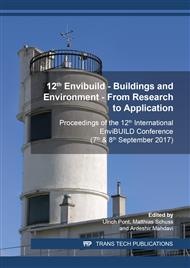p.428
p.435
p.443
p.451
p.459
p.467
p.475
p.484
p.492
Design of Fire Ventilation System for an Underground Car Park by CFD Simulations
Abstract:
The aim of this study is to design a fire ventilation system with impulse jet fans for an underground car park. During the planning, it is necessary to consider all aspects of fluid behaviour however, there is a number of parameters that can affect the flow of smoke that need to be considered. There is a good chance of miscalculations when computing the overall fluid flow using conventional plain calculations. To avoid mistakes, visualize the fluid flow and also to directly compare the different design variants it can be practical to use computer software, specifically CFD (Computational Fluid Dynamics) simulations. By CFD it is possible to better analyse and keep control of the flow of fluid, heat transfer and other related phenomena. It also helps predict the contamination level of Carbon Monoxide, heat and smoke intensity and distribution. In this study CFD simulations were used to design, test and compare two alternatives of fire ventilation system. The two alternatives differed from each other in the location of the impulse jet fans and exhaust ventilation shafts, and in the ventilation intensity (10-times per hour in the first alternative and 15-times per hour in the second alternative). The results have shown that the first alternative is not suitable as the car park was not sufficiently ventilated after 1500 seconds after the simulation had begun, whereas in the second alternative the smoke was almost completely exhausted and the visibility was significantly improved. The simulation results emphasize the important effect of design and location of the different elements on the functionality and efficiency of a fire protection system.
Info:
Periodical:
Pages:
459-466
Citation:
Online since:
January 2019
Authors:
Keywords:
Price:
Сopyright:
© 2019 Trans Tech Publications Ltd. All Rights Reserved
Share:
Citation:


